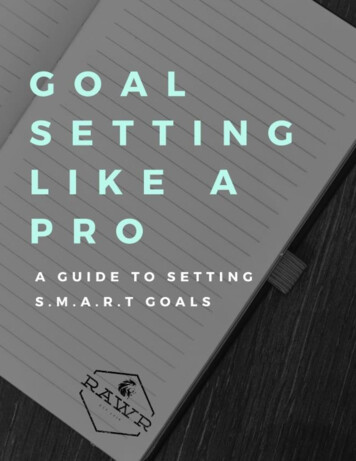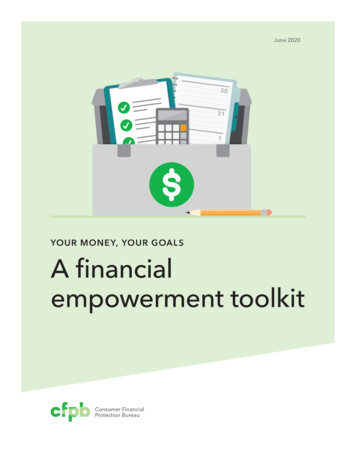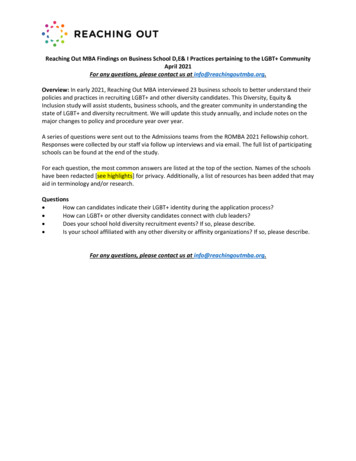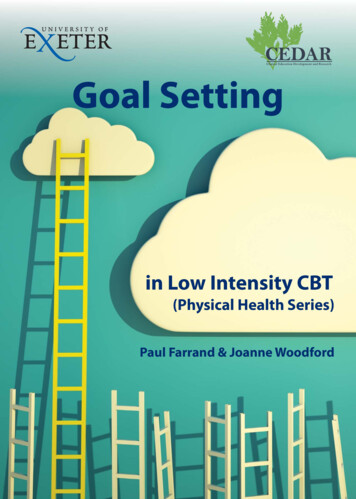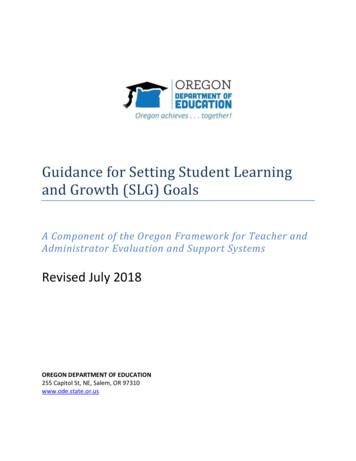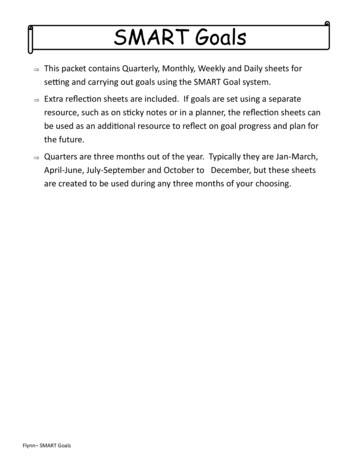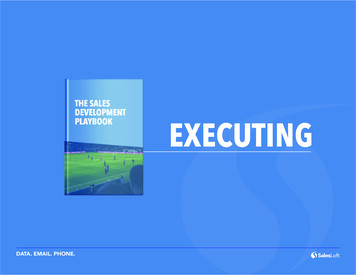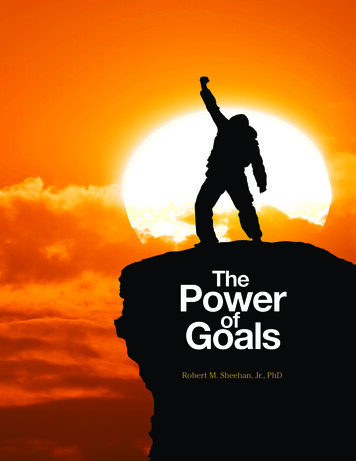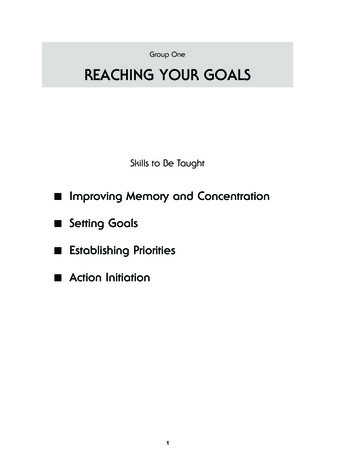
Transcription
Group OneREACHING YOUR GOALSSkills to Be Taught Improving Memory and Concentration Setting Goals Establishing Priorities Action Initiation1
Reaching Your GoalsCOUNSELOR TOOL BOXMulti-modal Presentation of Material:VerbalDidactic presentation of materialQuestioningGroup discussionVisualVisual presentation of major points using slidesGroup responses written on flipchart by counselorWritten/Pictorial handouts provided in Client l memory demonstrationIdentifying lifetime goalsPrioritizing lifetime goalsGetting started this weekConcentration/memory gamePost-group quizStress management/relaxation techniqueFlipchart markersOverhead projector and slidesAudiotape player and relaxation tapeClock/timerPens/pencilsPrizes“Loaner” Client WorkbooksHandouts:Group AgendaGroup QuizLifetime Goals ExercisePrioritizing Lifetime Goals worksheetAction initiationStep-by-step PlanningSensory Modality Memory Demonstration worksheet30 Concentration Game cardsCertificate of Achievement (as warranted)Ensure that all material on quiz is covered wellduring group.Quiz material is indicated by QUIZ ITEM in the text.Instructions to counselors are provided in this typeface.2
Reaching Your GoalsAGENDA(2-hour group: Adjust times based on beginning time)0:00Begin Group (5 mins)Introductions – Rules – Time keeper assignment0:05Introduction to Topic: “Reaching Your Goals”Addiction as a detour from lifetime goals (5 mins)0:10Memory Demonstration (Part I) (5 mins)0:15Prospective Memory (5 mins)0:20Effects of Drugs on the Brain (5 mins)0:25Multi-modal Strategies for Learning (5 mins)0:30External and Internal Memory Aids (15 mins)0:45Lifetime Goals Exercise (5 mins)0:50Discussion (10 mins)1:00BREAK (10 mins)1:10Review (5 mins)1:15Prioritizing Your Goals (5 mins)1:20Strategies for Taking the First Step (5 mins)1:25Game (15 mins)1:40Memory Demonstration (Part II) (5 mins)1:45Quiz and Feedback (5 mins)1:50Relaxation Tape (10 mins)2:00End3
Reaching Your GoalsBEGINNING OF EVERY GROUP (5 mins) Group members and counselors introduce themselves and welcomenew members Group rules are reviewedVisualShow Slide 1.1 Copy of agenda for today’s group is distributed to group members Ask for a volunteer to serve as time-keeper (to keep group on trackand on time) Announcement of any graduates from the group today Presentation of Certificate of Achievement to those who complete ingood standingVerbalCounselor provides introduction to today’s topic. (5 mins)The topic of today’s group is reaching your goals. Setting and reaching goalsis like starting out on a journey. If you keep your eye focused on your destination, make it your highest priority, and work steadily towards it, you canreach whatever personal goal you set for yourself in life. Chances are therewill always be some obstacles along the way, but most can be overcome.Drug addiction represents one of the largest barriers to reaching goalsbecause it completely changes your focus and your priorities.4
Reaching Your GoalsVisualShow Slide 1.2Imagine that this arrow represents your life journey – you set out on yourjourney, taking your first few steps towards discovering your purpose in lifeand identifying your lifetime goals. But then you start using drugs.Addiction is a major detour in your life journey. When you are addicted,your highest priority in life becomes getting and using drugs. That’s #1.Your highest priority is relieving symptoms of withdrawal and craving.Continued drug use creates additional problems that take you farther andfarther away from your goals. Furthermore, long-term drug use can have adetrimental effect on the very skills that you’ll need in your recovery thatwill get you back on the road toward your lifetime goals. It can affect yourmemory and concentration, your ability to manage time and get organized,and your ability to take the steps towards accomplishing your goals. As youcan see depicted on the slide, addiction is a detour that makes you spinout of control in an endless cycle of self-medication. The goal of thisgroup is to provide you with some tools that can help you get back on track.Today, we’ll talk about how to establish priorities, how to take the first stepstowards your goals, and we’ll provide you with some memory and concentration aids to help keep you on track.Counselor provides memory demonstration (Part I). (5 mins)We’re going to start with a memory demonstration that will have two parts.In the first part, I’m going to present you with a number of different itemsand ask you to remember them. While I am presenting these items, pleasedo not say or write anything, just watch and listen. Let’s begin:5Experiential
Reaching Your GoalsFirst, I’m going to show you 9 items for 15 seconds, and ask you to remember them.Counselor silently shows slide with 9 items for a totalof 15 seconds and then removes the slide.VisualFrogScissorsHatShow Slide 1.3HammerAnchorHamburgerTelephoneButterflyChairNow I’m going to name 9 items. Please listen carefully because I cannotrepeat them.Counselor reads the following items slowly and clearly.(3 items every 5 seconds for total of 15 BirdTableI’ll be asking you to recall these items later in the group, but right now weare going to talk about different types of memory.VerbalCounselor covers Prospective Memory as follows: (5 mins)QUESTION: Does anyone know what prospective memory is?6
Reaching Your GoalsWhen we think of memory, we usually think of memory for past events.Prospective memory is different. Prospective memory is the type ofmemory required to carry out actions in the future.VisualShow Slide 1.4For example, remembering to come to group next week, remembering to goto your next doctor’s appointment, remembering to use a condom next timeyou have sex, remembering to use a new needle or to clean your needle properly if you make the decision to inject drugs — these are all examples ofprospective memory. We are going to concentrate on prospective memorytoday because it is extremely important in maintaining your health andmeeting your recovery goals, and because many drug users have difficultywith prospective memory.Counselor covers effects of drug use on the brain. (5 mins)Remember the anti-drug public service announcement that used to be shownon TV that showed an egg going into a frying pan and said—7Verbal
Reaching Your GoalsVisualShow Slide 1.5“This is your brain This is your brain on drugs.”Well, here’s the real thing.VisualShow Slide 1.6This really is your brain and This really is your brain on drugs. The threeimages you see at the top of this slide are actual brain scans of a non-druguser. The red color depicts the flow of blood to various parts of the brain. Itis particularly noticeable in the center image. This is what a normal brainlooks like. The three images on the bottom are brain scans of a cocaine user.Notice how little red there is compared to the scans of the normal brain.That means that cocaine users have reduced blood flow to many parts of thebrain.8
Reaching Your GoalsSo why is blood flow so important? Reduced blood flow can mean:Show Slide 1.7 Learning and memory impairmentProblems with attention and concentrationProblems just getting started and learning how to interpret feedbackMental inflexibilityPoor judgmentThe good news is that you can prevent further damage and even possiblyreverse some of the damage if you stop using drugs. You should not assumethat if you already have any of these problems that your cognitive ability isnow out of your control. There are many things that you can do that areunder your control. Being abstinent from drugs is very important, andyou’ve taken a very important first step by getting into treatment. However,in order to gain the greatest benefit from this program and prevent relapse,you will need to learn and remember a number of recovery skills that youwill be taught in these groups. Therefore, one of our goals is to help youcompensate for any learning and memory difficulties you may currently behaving so that you can get what you need from this program.Counselor describes multi-modal strategies for learning as follows: (5 mins)People learn and remember differently. Some people find it easier toremember what they see, others what they hear, and others remember bydoing. This is why all the groups you receive present the material in severaldifferent ways – we call this a multi-modal presentation, and we use itspecifically to help you learn and remember what is taught in these groups.9Verbal
Reaching Your GoalsVisualShow Slide 1.8All material is presented to you verbally. However, you’ll also notice thatmajor points are presented visually on the screen behind me. We’ll also beasking you questions and writing on the flipchart. And you may think werepeat a lot, but reviewing information is a good way to remember.Another way to learn and remember, and to have some fun at the sametime, is experiential – we will play a game or provide a demonstration thatwill permit you to interact with the material being presented on a physicallevel because some people learn best when they actually engage in an activity. We also use memory books (that’s your client workbook) which we willbe discussing soon. In addition, because fatigue can interfere with memoryand concentration, we provide a break midway. Structure and consistency also aids learning; that’s why we provide an agenda at the beginning ofgroup and ask one of you to act as the timekeeper so that we keep on track.Asking yourself questions about material also helps you remember it. That’swhy we ask questions during the group to help you focus on the topic andat the end of the group we give you a brief quiz with immediate feedbackto make sure we did our job well and that you understand the major points.Finally, before we adjourn, we all do a 10-minute stress managementexercise because being relaxed and centered is key to learning new information and retrieving old information. It will also be of help to you in handling drug craving. We’ll talk more about that in another group.VerbalCounselor presents External and Internal Memory Aids as follows: (15 mins)External Memory AidsAs you will see there are many ways to help improve memory and learning.One method we will be relying on in this group is the memory book system.10
Reaching Your GoalsAn example of a memory book is your Client Workbook. Each of you wereprovided with your own Client Workbook and were shown how to use itwhen you began this treatment program. You were asked to bring it toevery group. Does everyone have their Client Workbooks? If anyone hasforgotten to bring it, we have a few extra here that you can borrow duringthis group, but please remember to bring yours with you next time. TheClient Workbook has sections for keeping your personal information, emergency information, your schedules and appointments, to-do lists, importantnames and telephone numbers, and information and community referralsprovided in these groups. Your Client Workbook is an example of an external memory aid. QUIZ ITEMExternal memory aids are designed to store information externally and tocue you to take action. Here are some more examples of external memoryaids.VisualShow Slide 1.9To do listWatchCalendarAddress bookAlarmGrocery list QUIZ ITEMPost-it noteMapBulletin BoardAppointment bookItem Placement11
Reaching Your GoalsCounselor lists the above items, finishing with item placement.QUESTION: Does anyone know how item placement aids memory?Counselor begins a discussion of how to structure the environmentto aid memory. An example of item placement as a memory aid is to place somethingyou need to remember near the front door, or in the same place youkeep your wallet or keys. Have clock, calendar, and bulletin board hung in places that are easyto see. Label shelves. Put instructions next to appliances. Once the room is set up a particular way, don’t change it. For example, don’t rearrange the pots, or change where you keep your keys.QUESTION: Can anyone give me an example of an external memory aidyou can use to help you remember to bring your Client Workbook to everygroup?Counselor leads a discussion of ways to remember to bringthe Client Workbook.You could leave a note on your refrigerator, you could leave your memorybook near the front door, or in the same place as you leave your keys andwallet. Any other ideas?Counselor writes strategies for remembering to bring Client Workbook onthe board and adds additional ideas provided by group members.Internal Memory AidsSo far, we’ve talked about external memory aids. This slide also providessome internal memory aids.12
Reaching Your GoalsVisualShow Slide 1.10Another word for internal memory aids is “mnemonics.” Mnemonics addsomething to the information to be remembered to make it more memorable.There are a number of different kinds of internal memory aids. On the slideyou can see just a few examples: The first example is Story telling:Some people find it is easier to remember a story than a series of unrelatedwords. Therefore, to remember a list of tasks, make up a story about them.If you make the story funny or bizarre it will help you remember better.Example: You have the following list of things to do tomorrow:1.2.3.4.5.Go to the clinic for methadoneFill out a job applicationGo to the bank to pay billsVisit a friend in hospitalBuy chicken for dinnerSo you have to remember methadone, job application, bank, sick friend, andchicken. Now make up a story: For example, how about this?“When I was in line for methadone this morning, my friendtold me about this really sick dude who dressed up in achicken suit and applied for a job as a bank loan officer;figures, he got the job.” The second example of an internal memory aid is Organization:13
Reaching Your GoalsCategorizing information is an effective way to organize and rememberinformation. Example: when trying to remember what you have to dotomorrow, list your activities under category headings, such as: appointments, chores, leisure activities. Then when you recall the category, it willcue you to remember the specific item. The third example is called First Letter Cueing:An acronym is an example of first letter cueing. It makes a word out of thefirst letters of the items to be remembered. For example: H-A-L-T is a wordsome people use to help them remember triggers for drug use and otherrisky behavior. HALT stands for Hungry-Angry-Lonely-Tired. The fourth example is Repetition:Information is easier to recall when it is “over-learned.” Therefore, repeatthe information to yourself frequently, and even when you have learned it,review it frequently. Last, but certainly not least is Relaxation:Stress and anxiety block learning and memory. When you have memory difficulties, it is easy to get frustrated and overwhelmed, and these feelings canfurther impair your memory and learning abilities. It is therefore extremelyimportant to learn how to calm yourself. The relaxation technique we do atthe end of every group is a valuable memory tool for you, for many reasons.QUIZ ITEM If you have a mental block and just can’t remember something, take a break from trying to remember, do a relaxation exercise, andtry again later when you are more relaxed. Whenever you get overwhelmedor frustrated, it’s important to just stop what you are doing, and calm yourself. When you “slow down the action” you can think more clearly.Verbal“Slowing down the action” and thinking clearly is essential for setting andmeeting your goals. Please turn to the “Lifetime goals exercise” in yourClient Workbook. If you forgot your workbook today, you can use one ofthese hand-outs and place it in your workbook when you get home.14
Reaching Your GoalsLIFETIME GOALS EXERCISE (5 mins)Counselor distributes “Lifetime Goals Exercise” hand-outs to those withouttheir Client Workbooks.Materials Lifetime Goals Exercise Handout Pen/pencil Clock/watchInstructionsOn your Lifetime Goals Exercise sheet, list your lifetime goals before youstarted using drugs. Think back. Write down whatever comes to mind, nomatter how far fetched it may seem to you now. If you didn’t have any lifetime goals or can’t remember any, write down some lifetime goals that youwould have had, if you could turn back time.Counselor allows 5 minutes for everyone to finish their list.QUESTION: What does it mean to prioritize your goals?Answer: To prioritize means to list your goals in order of importanceQUIZ ITEMQUESTION: Can priorities change?Answer: Yes. For example, people who are facing health problems oftenquickly realize what is and is not important in their lives. What they oncethought was important may have low priority now, and what had low priority before becoming ill, may now have high priority. (Example: A man findsout he has heart disease. Prior to the diagnosis attending to his work mayhave had a higher priority than maintaining good family relationships, andmay have taken most of his time, whereas now his priorities have changedand he feels that it is more important to spend time with his family.)Counselor leads a discussion with the following questions: (10 mins)15Experiential
Reaching Your Goals Have there been any changes in your lifetime goals since becomingaddicted to drugs? Can you accomplish your lifetime goals and still use drugs? Why or why not? After the break, we are going to be talking about establishing priorities. During the break, we’d like you to consider the following: If getting and using drugs used to be your #1 priority before entering treatment, what is your #1 priority now that you are in this program?Break(10 mins)Let’s take a break now, and start again in 10 minutes. Time-keeper, pleaseget everyone back in time.ReviewAfter the break, counselor reviews the material covered so far. (5 mins)Before the break we talked about addiction as a barrier to achieving yourgoals and causing damage to your brain which results in learning and memory problems that, in turn, can also prevent you from achieving your goals.We discussed prospective memory, which is memory required to carry outfuture events, and we discussed tools that you can use to improve yourprospective memory. We focused on external memory aids, such as yourClient Workbook, which is a memory book in which you keep your personalinformation, to-do lists, calendars, schedules, important names and phonenumbers, and where you can keep reference material provided in this program. We also identified other external memory aids such as, grocery lists,alarms, leaving post-it notes on the bathroom mirror or refrigerator, andarranging your environment to help you remember. We also explained whyyou need basic memory and concentration skills in order to meet your goals.And, before the break, we asked you to write down some of the goals youhad before you started using drugs and asked you to consider what yourgoals are now that you have entered treatment.VerbalCounselor presents material on Establishing Priorities as follows: (5 mins)16
Reaching Your GoalsNow we are going to talk about how to meet your goals.VisualShow Slide 1.11Counselor shows the “Taking Steps” slide and leaves it on throughout theupcoming experiential segment which reviews each point on slide.The first thing you need to do is to determine which goal has highest priority. Now please turn to the “Prioritizing Lifetime Goals” hand-out in yourClient Workbook. Again, if you forgot your workbook today, you can use oneof these hand-outs and place it in your workbook when you get home.Counselor distributes “Prioritizing Lifetime Goals” hand-outs to thosewithout their Client Workbooks.Materials “Prioritizing Lifetime Goals” Pen/pencilInstructionsAs a member of HHRP, you’ve expressed an interest in living a healthylifestyle. On your “Prioritizing Lifetime Goals” handout, we listed this goalas an example that we can all work on together. Each of you look at yourown list of personal lifetime goals and enter the three that are highest priority to you in the spaces on your handout for goals No. 1, No. 2, and No.3.17Experiential
Reaching Your GoalsCounselor gives group members a few minutes to identify and enter theirNo. 1, No. 2, and No. 3 highest priorities in the designated space on theirhandouts.GETTING STARTEDOnce you have identified your most important goals, you need to determinehow you are going to get started so that you can reach those goals. For thegoal which is your highest priority, decide on the specific steps or actionsnecessary to meet this goal and in what order you need to take these steps.For purposes of demonstration, we provided the example of “living a healthylifestyle” as a priority for everyone in this treatment program. But that isan extremely large goal with so many possibilities that it may seem overwhelming and unobtainable. We have selected this goal because it is typicalof the kinds of non-specific goals that people set for themselves. Therefore,as you will see on the slide and on your hand-out, the very first thing we dois to take this large and complicated goal and break it down into smaller,manageable tasks or activities.QUIZ ITEMAs you can see on your handout,Sample Goal: To live a healthy lifestyleActivities Stay in this treatment programEat healthy foodsRemain abstinent from illicit drugsTake vitaminsUse condomsKeep doctors’ appointmentsTake medications (if any) as prescribedDo relaxation techniquesExercise regularlyThink positivelyEngage in drug-free leisure activitiesOther18
Reaching Your GoalsCounselor asks group for other examples of appropriate activities thatcan be written in space provided under “other.”But what if you still feel overwhelmed? Perhaps the activity “eating healthyfoods” is not one step and needs to be broken down into even smaller steps,such as “eat a green leafy vegetable every day.” You need to prioritize theactivities needed to reach your goal and to make a plan for exactly how youwill begin. We’ll do this next.Instructions: You’ve identified your goals and prioritized them, butremember every journey begins with a single step. What is your first step?You need to select something relatively small, something manageable, something that you can do this week that will begin your journey toward yourgoal. In the space provided on your “Prioritizing Lifetime Goals” hand-out,write in what you can do this week that will get you closer to your goal of“living a healthy lifestyle.” Be very specific. The more specific you are, themore likely you are to do it. Use the word “do” not the word “don’t.” Manypeople may be tempted to write “this week I won’t use drugs.” That is certainly an understandable goal, but you will be more likely to accomplish it ifyou write down an activity you can actually do that can help you not to usedrugs.Counselor provides examples, such as go to an NA meeting, get anNA sponsor, engage in drug-free activity with non-drug using friend orfamily member.If you think of several activities, prioritize them. What’s the most importantthing you can do this week to move you towards your goal of living ahealthy lifestyle?Counselor provides time for group members to write on their handoutthe activity they will do THIS WEEK. When everyone has written downone activity on their sheet, counselor continues.19Experiential
Reaching Your GoalsVerbalCounselor describes action initiation strategies. (5 mins)Some people find that it is easy to identify the activity necessary to accomplish the goal, but find it difficult to get started with the activity, and therefore never reach their goal. Remember the journey towards your goal beginswith the very first step. There are several things you can do that will helpyou take that first step. We are now at step #5 on the slide. As you can see,the first thing to do is: Schedule the activity.Counselor refers group members to the “Action Initiation” handout intheir Client Workbooks and writes the following on the board:SCHEDULE THE ACTIVITYTo do listSet deadlineBlock out time1. Write the activity on a to-do list. QUIZ ITEMExperientialLet’s do this now. Turn to the “Step-by-Step Planning Worksheet” in yourClient Workbook and write down the steps you need to take to do to engagein the activity that you identified in the previous exercise that you are goingto do this week towards the goal of “living a healthy lifestyle.”Counselor provides an example, e.g., if the activity was to go to an NAmeeting, write “check NA schedule and go to a meeting.” Allow time forgroup members to make an entry on their to-do list.If you are not careful, a to-do list can also become unmanageable and youcan end up with a list so long that you feel overwhelmed.Keep your daily “To-Do List” do-able: set priorities for what is to be accomplished. check the to-do list every morning to see what needs to be done first at the end of each day check off what was completed that day, andwrite what was not completed on the next day’s “To-Do” list.20
Reaching Your GoalsYou cannot expect to reach your goal in a single day; however, it will motivate you to see it on your “to do” list every day, and to see how the steps necessary to achieve the goal are being checked off as completed.2. Set a deadline: Set a deadline for completion of the activity and markit on your calendar: Be realistic. Don’t set yourself up for failure.QUIZ ITEMDo this now. Mark your deadline for completion of this activity on your“Step-by-Step Planning Worksheet.” Because you have agreed to engage inthe activity some time during the coming week, your deadline is one weekfrom today’ date.ExperientialCounselor provides time for group members to enter deadline on theirweekly worksheet.3. Block out time: Block out time on your weekly schedule to engage inthe activity during the coming week. QUIZ ITEM Select times thatare best for you. If others are involved, make sure the scheduled time isconvenient for them too.Turn now to your weekly schedule at the beginning of your Client Workbookand check to see what times are available on the date you selected to engagein the activity during the coming week. Now block out that time on yourschedule and also write it on your Step-by-Step Planning Worksheet.Counselor provides time for group members to select and enter a timeblock for the activity.GETTING STARTEDThat brings us to item #6 on the slide—getting started. So now youhave your activity scheduled, how will you get started?21Verbal
Reaching Your GoalsCounselor refers group members back to their “Action Initiation” handoutand writes the following on the board:GETTING STARTEDRemindersSelf-affirmationsTell someoneSet a time limitRelax/visualizeAct “as if”Start anywhereDon’t expect perfection Leave yourself reminders to engage in the activity Use self-affirmations (say to yourself “I can do it”) Tell someone else what you are planning to do so that they can encourage you; don’t keep it a secret QUIZ ITEMQUESTION: What if the time for the activity arrives and you just can’t getstarted? Set a time limit (contract with yourself to engage in the activity forjust 5 minutes) QUIZ ITEM Relax and visualize yourself engaging in the activity QUIZ ITEM Pretend you are an actor playing the role of a person who can engagein the activity You don’t have to start at the beginning, start anywhere QUIZ ITEM Remind yourself that it doesn’t have to be perfect QUIZ ITEMThe last step then is to engage in the activity. During the weekengage in the activity you selected. Then as shown in your handout,there are two more important things for you to do:Counselor refers group members back to their “Action Initiation” handoutand writes the following on the board:Engage in the activityCongratulate yourselfCross it off your to-do list22
Reaching Your Goals Congratulate yourself. Acknowledging your accomplishments ateach step gives you confidence for the next step. There is no suchthing as an insignificant accomplishment. Each step, no matter howsmall, is absolutely essential for reaching your goal, and therefore ofimportance. Cross it off your to-do list.So that brings us to Step #8 on the “Taking Steps” slide. At this point, selectthe next most important activity on your list that will move you closer toyour goal of living a healthy lifestyle, and just repeat steps 5 through 8.Counselor leads discussion concerning how each group membercompleted their “Prioritizing Lifetime Goals,” “Step-by-Step PlanningWorksheet,” and “Weekly Schedule.”DiscussionQUESTIONS: Was the activity specific and do-able? Does the activity needto be simplified? Is there sufficient time blocked out? How committed is theindividual to engaging in the activity?Counselor encourages group members to use this process at home tobegin moving towards the goals they set for themselves as their #1, #2,and #3 priorities.Game: Concentration (15 mins).Experiential/GameMaterials 30 picture cards (attached) Clock Prizes (e.g., “fruit or vegetable” fridge magnets to post reminders)Counselor (Therapeutic goals of the game) Improve memory Improve concentration Review activities that can lead towards goal of “living a healthylifestyle” Encourage teamwork and appropriate social interaction23
Reaching Your GoalsInstructions: I’m going to place 15 identical pairs of pictures face down onthe table. The pictures are relevant to your goal of “living a healthylifestyle.” I’m going to divide the group into two teams.Counselor divides the group into two teams.You are going to take turns. First player in Team 1 turns over two cardsand then places them face down again. Everyone takes turns to turn overtwo cards for everyone to see; the item on the back of the card and the location of the card is to be remembered by the players. If the two cards do notmatch, the cards are placed face down on the table again (with only thenumber sho
Counselor presents External and Internal Memory Aids as follows: (15 mins) External Memory Aids As you will see there are many ways to help improve memory and learning. One method we will be relying on in th
